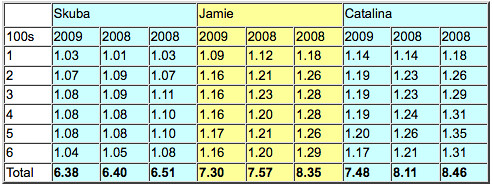… or why we were not surprised.
By Jane
Last week, Australian swimmer Nick D’Arcy received a fourteen-month suspended sentence for his March 2008 assault on former Australian breaststroke star Simon Cowley. If you’re into swimming, you know about this. The assault took place hours–not days–after D’Arcy won the 200m butterfly at the Australian Olympic Trials, supposedly securing his place on the country’s Olympic team. The injuries inflicted when the mean end of D’Arcy’s elbow connected with Cowley disfigured Cowley enough to require metal plates be implanted in his face. D’Arcy was accordingly thrown off the Australian swim team. Almost exactly a year after the assault, he has qualified to swim in the Rome World Championships and has been handed his official punishment.
It was a horrifying incident and it sullied the name of swimming, a sport generally regarded as being relatively violence-free. In all the discussion about the fight, however, something very troubling was barely touched upon, and it’s something only a member of the swimming community could really vocalise. It was the fact that many of us were not at all surprised.
Of course we were surprised. No one imagines that a newly-crowned national champion and Olympian would allow himself to do something the likes of what D’Arcy did. Living in the United States at the time (a country not nearly as obsessed with swimming as Australia), I didn’t find out about the fight until I went to Sydney at the beginning of April. Sitting in a Sydney bar and listening to the story, about a kilometre from the scene of the fight, I couldn’t believe swimming had descended to the level of rugby league and British football. We’re nice kids. We don’t do things like destroy each other’s faces.
But hindsight is really interesting, and now, a year on, I am not surprised. In fact, it’s amazing that it took until 2008 for someone to do something like this.
When I began swimming well, I was about fifteen and it was 1999. I am two and a half years older than Nick D’Arcy and I never knew him, but I knew the two generations of male swimmers who came before him. They were not saints, but their culture was different.
You had your smart-arses and your idiots, and we all liked a drink, but I remember there being a lack of serious machismo in those people. When I say serious, I mean that they did not take themselves as seriously as they might have. Fantastic athletes like James Hickman of Great Britain and Bill Kirby from Australia were polite and personable, and certainly never displayed any tendancy towards violence. A few years later, I’d find some of their successors, across many countries, to be very different. Suddenly, a selection of the Aussie guys no longer smiled at you: they leered at you with curled lips and suggestive expressions. They weren’t the types of people you’d want to be around when they’d been drinking, and you’d never let yourself be alone with them, alcohol or not. You had your notable exceptions from the previous generation, such as the disgraced Scott Miller, but the culture was not one in which anyone felt uncomfortable.
Sometime in between the year 2000 and March 31, 2008, a culture grew in swimming where some of these guys really believed that they were all that. I speak from experience and opinion alone, but some of them believed their own hype to the extent that they thought they should have anything and anyone they wanted. The eventual result of a culture like this is usually an incident like that between D’Arcy and Cowley. However, it’s only a ‘wake-up call’ if the community realises what really happened.
Again, I’m not saying that the 1999 generation were angels, but they were different. Some will blame this on money: get good enough nowadays, and swimming can now make you very rich. I don’t necessarily believe that this is the crux of the problem; however, I do believe that those people in charge of swimming federations worldwide should be very mindful of the culture building in their midst. There is a marked difference between having 21 year olds misbehave, spend all night after a competition at bars, puke in a gutter and even mouth off at a teammate, and letting a culture manifest where menacing arrogance is acceptable. When I think about what I saw become acceptable swimming culture, I’m not surprised that Nick D’Arcy did what he did.
It isn’t that far fetched that swimming could be let to turn into rugby league or European football, where every second week wouldn’t be complete without a competitor being hauled before a judge for smacking someone around. I know a lot of swimmers who do embody the characteristics of those people who were great in the 90s. My father coaches some of them in Florida. In other parts of the world, however, there’s a dangerous culture brewing. Let D’Arcy’s case be a warning, and stifle a culture that could turn swimming into something none of us want it to be.





